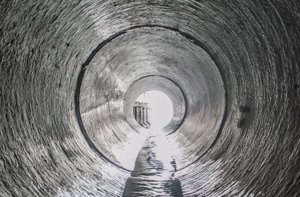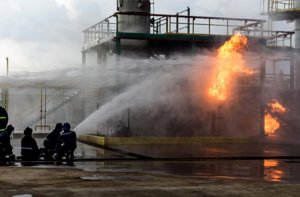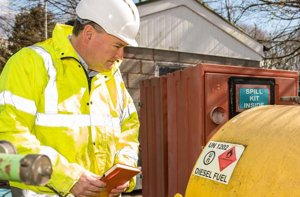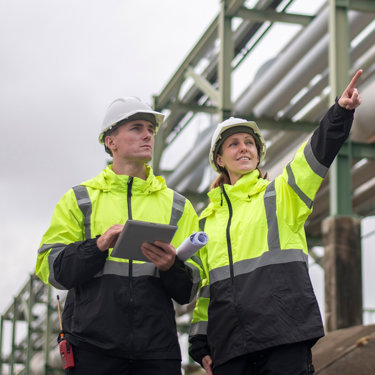
Environmental compliance assessment
Ready to discuss your project?
Please leave your details and a member of our team will reach out to discuss your requirements in more detail and arrange next steps.
We help organisations ensure the integrity, condition, and compliance of industrial assets with our environmental compliance assessments. This allows you to attain and maintain custody of your sites, identify gaps in your compliance, identify future risk scenarios, and develop a strategic asset priority map, efficiently and within your budget.
We take a holistic approach to identify if containment is appropriate to the assets purpose, in line with CIRIA C736 and associated guidance. Assessments are carried out on a risk-based approach and with due consideration of site procedures and the surrounding environment. This enables you to develop an appropriate risk-based asset management system.
We take our customers on a compliance journey which involves:
- GAP analysis
- Assessment / investigation
- Risk prioritisation
- Improvement plan
- PPM schedule including inspection cycle
We can help you build the following environmental security assessments:
- Baseline asset survey and gap analysis
- Environmental drainage plan
- Firewater containment plan
The Environmental Security Assessment and Gap Analysis will identify:
- What assets do you operate? Where are they?
- Do you have original ‘As Built’ information, make and model and service history for each asset?
- Do you have site environmental setting information?
- Do you have a site layout plan?
- Do you have an up to date and accurate drainage plan?
- Has your separator had a 5 yearly inspection test?
Have there been any material changes on site since installation? E.g. new tanks, change in drainage layout, etc
How we can help

Baseline asset survey and gap analysis

Environmental drainage plan

Firewater containment plan

DSEAR risk assessment
Benefits
- Establish your sites assets current compliance.
- Identify information gaps and non-compliances.
- Establish a programme to address any information gaps in Baseline Asset Information.
- Provide medium/long term recommendations to develop site improvement plan or confirm compliance.
Added value
Compliance
Efficiency
Risk reduction
Mitigating factor
Legislation
A pollution incident as a result of a poorly maintained asset is a strict liability offence.
Two of the principle laws the regulators would be looking to establish that you had breached in the event of an environmental incident are:
The Water Resources Act 1991 (as amended)
It is an offence to cause or knowingly permit any poisonous, noxious, or polluting material, or any solid waste to enter any controlled water.
Environmental Permitting Regulations 2016
It is an offence to cause or knowingly permit a water discharge activity or a groundwater activity without an environmental permit (regulation 38, EP Regulations 2016).
These are supported by several standards and good practice.
Internationally recognised standards include:
- ISO – Internationally recognised standards (ISO)
- CEN/CENLEC – European Standard 34 countries – 27 in EU. (EN)
- BSI – British Standard (BS)
- BS EN – European standard fully adopted in UK (BS EN)
- BS EN ISO – Internationally integrated standard
Good practice developed by professional, trade body and regulatory good practice guidance, include:
- PPG –Pollution Prevention Guidelines (Withdrawn) – Regulator issued EA lead.
- GPP – Guidance for Pollution Prevention – Regulator issued SEPA, NIEA
- CIRIA C736 Containment systems for the prevention of pollution – CIRIA
- CIRIA C753 The SUDS Manual
- Control of Pollution (Oil Storage) (England) Regulations 2001
Find out more about these regulations, standards, and good practice in our Knowledge Hub.
How do the regulators assess your site?
The COMAH Safety Report Assessment Manual SRAM 13 – Environmental Aspects – Technical Criterion 13.9 requires demonstration that ‘The Operator has designed, built, operates and maintains the containment equipment and process on the establishment to recognised standards and practices.’ It further requires that the standards and good practice guidance is referenced.
Although these requirements are designed for sites that come under COMAH Regulations, the principles cascade down to all sites. This can be illustrated when reviewing
Regulator issued CAR (Compliance Assessment Report) papers –which regularly state that the operator must provide evidence that their asset/facility meets a specific standard or good practice:
Example:
- Assess how tanks will be bunded to meet CIRIA C736.
- Site should assess what class of containment is required for the site from CIRIA C736.
- Bund each tank or group tanks and install bund around them which meets CIRIA C736.
How is this used when considering enforcement action?
The Sentencing Council Environmental Offences, Definitive Guidelines 2014 state:
- A pollution incident because of a wrongly specified or poorly maintained asset is a strict liability offence.
- Under the Sentencing Council Guideline for Environmental Offences (SCGEO), non-compliance with standards and good practice is considered an ‘aggravating factor’ and could result in the offence being categorised as ‘reckless’ or ‘deliberate’.
- The impact would be more stringent enforcement action and penalties, in line with the structure set out in the SCGEO.
- Failure to adhere can also invalidate insurance.
If a pollution incident occurs
A poorly specified, operated and maintained asset with inadequate service and inspection records would be seen as an aggravating factor.
While
A correctly specified, operated, and maintained asset with compliant service and inspection records would be seen as a mitigating factor.
Environmental compliance today, creating a sustainable tomorrow
Helping you reduce risk to the environment and your operation by managing assets compliantly while achieving commercial, ESG, and net-zero goals.
Contact our experts
